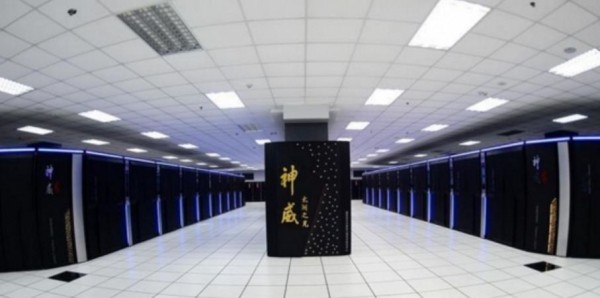China and United States are in intense competition for world supercomputer supremacy, according to data from the 48th edition of the TOP500 list of supercomputers worldwide.
Each country has 171 systems apiece in the latest rankings released Nov. 14, and account for two-thirds of the computers on the list. China has maintained its dominance at the top of the list with the same number 1 and 2 systems listed last June: Sunway TaihuLight at 93 petaFLOPS and Tianhe-2 at 34 petaFLOPS.
Germany claims the third most number of systems with 31. Next are Japan with 27; France with 20 and the United Kingdom with 13.
In 2015, the U.S. was the clear leader with 200 systems. China had 108; Japan had 37; Germany had 33 and both France and the UK had 18.
Sunway TaihuLight's unprecedented 93 petaFLOPS on the LINPACK benchmark is nearly three times better than the previous number one system, Tianhe-2, which was the world's fastest for past three years.
Sunway TaihuLight is also five times faster than Titan, the 17 petaFLOPS machine at the Oak Ridge National Laboratory in Tennessee, the fastest supercomputer in the United States.
Sunway TaihuLight also has a theoretical peak performance of 125.4 petaFLOPS. It is the first system to exceed 100 petaFLOPS. The machine is a monolithic system with 10.65 million compute cores built entirely with Chinese microprocessors. There is no U.S.-made supercomputer system that comes close to the performance of Sunway TaihuLight.
The LINPACK benchmarks are used to benchmark and rank supercomputers for the TOP500 list. A petaFLOPS supercomputer has a sustained speed of 1015 FLOPS or one thousand trillion (one quadrillion) FLOPS.
FLOPS stands for "floating-point operations per second" and is a measure of computer performance.
TaihuLight, which is installed at China's National Supercomputing Center in Wuxi, uses ShenWei CPUs developed by Jiangnan Computing Research Lab in Wuxi. The operating system is a Linux-based Chinese system called Sunway Raise.
China and the U.S. are also running neck and neck in aggregate Linpack performance. The US holds the narrowest of leads, with 33.9 percent of the total; China is second with 33.3 percent.
The total performance of all 500 computers on the list is now 672 petaflops, a 60 percent increase from a year ago.
The top of the list did receive a mild shakeup with two new systems in the Top 10.
The Cori supercomputer, a Cray XC40 system installed at Berkeley Lab's National Energy Research Scientific Computing Center (NERSC), slipped into the number 5 slot with a Linpack rating of 14.0 petaflops.
At number 6 is the new Oakforest-PACS supercomputer, a Fujitsu PRIMERGY CX1640 M1 cluster, which recorded a Linpack mark of 13.6 petaflops. Oakforest-PACS is up and running at Japan's Joint Center for Advanced High Performance Computing (JCAHPC).
Both machines owe their computing prowess to the Intel "Knights Landing" Xeon Phi 7250, a 68-core processor that delivers 3 peak teraflops of performance.
The addition of Cori and Oakforest-PACS pushed every system below them a couple of notches down, with the exception of Piz Daint, a Cray supercomputer installed at the Swiss National Supercomputing Centre (CSCS).
It maintained its spot at number 8 as a result of a massive 3.5 petaflop upgrade, courtesy of newly installed NVIDIA P100 Tesla GPUs.
Piz Daint is also the second most energy-efficient supercomputer in the TOP500, with a rating of 7.45 gigaflops/watt. It is topped by NVIDIA's in-house DGX SATURNV system, the only other system on the list equipped with the new P100 GPUs.
It is a 3.3-petaflop cluster of DGX-1 servers that delivers 9.46 gigaflops/watt. To offer some perspective here, the nominal goal for the first exascale systems is 50 gigaflops/watt.
Systems greater than one petaflop now occupy the first 117 positions, or nearly a quarter of the TOP500. A year ago, that number was 81.
At the other end of the list, the entry level system is now 349.3 teraflops, compared to 206.3 teraflops in November 2015.
Intel continues to be the dominant chip provider, claiming representation in 462 (92.4 percent) of all systems. IBM Power processors are present in 22 systems. AMD processor share continues to decline, with just 7 systems on the current list, down from 13 systems just six months ago.
InfiniBand technology is now found on 187 systems, down from 205 systems six months ago, and is now the second most used system interconnect in the TOP500. Gigabit Ethernet is now at 206 systems down from 218 systems, in large part thanks to 178 systems now using 10 Gigabit Ethernet technology.
Intel Omni-Path technology which made its first appearance on the list six month ago with 8 systems, is now present in 28 systems, including the new 13.6 petaflop Oakforest-PACS supercomputer.
Of all system providers, Hewlett Packard Enterprise claims the most systems with 140. That number includes the 28 systems installed by SGI, which has been acquired by HPE. In second place is Lenovo with 92 systems.
Cray claims just 56 systems, but it continues to lead all vendors in aggregate performance with 21.3 percent of the total. IBM is now in 5th place in the systems category with 33, all of which were present on the previous list. The next supercomputer list will be issued in June 2017.


